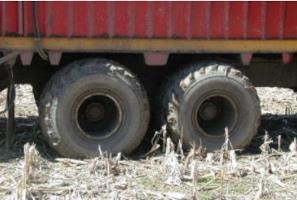By Sjoerd Willem Duiker
Soil is like the skin of the earth - it is a very thin layer but lo, when it is damaged, you are in for major trouble! Farmers are dependent on the health of their soil to reap good harvests while this is also a stewardship issue because soil in poor health will cause environmental problems that affect others, such as greater runoff, erosion and nutrient losses. That is why it is so important to avoid soil compaction. The 2017 Ag Census shows that the number of Pennsylvania farms declined 10% since the previous census (2012) to 53,157 farms, while farmland decreased 6%. Farm size was therefore up 5%. And you get it – larger farms = larger farm equipment = greater threat of soil compaction!

While soil compaction is not a big concern when the soil is bone dry, it is during wet soil conditions such as those we are experiencing this fall that it becomes so important to be set up to avoid compacting your soil. Soil compaction reduces total pore volume by compressing the larger pores in the soil. This leads to higher bulk density, reduced macro-porosity and increased penetration resistance. The implications are reductions in root growth of following crops, increased runoff, increased nitrogen losses due to denitrification and ammonia volatilization, reduced uptake of immobile nutrients such as phosphorus and potassium, and eventually, reduced yields. Equipment can cause surface compaction (<12") and subsoil compaction (>12"). We make the difference because surface compaction has been shown to be primarily related to contact pressure (pounds per square inch), while subsoil compaction is primarily related to axle load (e.g. tons per axle, or per wheel). Surface compaction effects are the most detrimental in the immediate future, but they don’t last as long as the smaller reductions in soil function due to subsoil compaction. This is the result of more biological activity and freeze-thaw and wet-dry cycles in the surface soil than in the subsoil.
The aim of soil compaction management is therefore to eliminate subsoil compaction and reduce surface compaction as much as possible. You can make your soil resist surface compaction by using soil health improving practices such as no-tillage, maintaining living root systems in the soil as much of the year as possible, and building organic matter content. But there is a limit to what even the most healthy soil can sustain, and therefore a farmer should do what is possible to avoid causing compaction.
Here are some tips for soil compaction avoidance:
- Evaluate your soil types and field position and harvest the fields with lighter, drier soil first. For example, if you have sandy, shale, and limestone soil on the farm, you could harvest the sandy and shaly fields first. Higher-laying fields or those on south-facing slopes would be first candidates to be harvested because they dry out faster.
- Reduce the trafficked area. It is advised to create traffic lanes instead of running all over the field. Companies are coming out with new GPS software systems that can be used to manage field traffic better, such as Machine Sync or AutoTracTM from John Deere. If possible, you should unload when the combine reaches the edge of the field where the truck is parked.
- Don’t take dump trucks and tractor trailers with road tires inflated to 95-105 psi into the field but park them at the field edge. These vehicles have a very small footprint and cause high surface soil compaction.
- Increase harvester, combine, tractor, silage wagons, dump trucks and grain cart footprint by reducing tire inflation pressure to the lowest allowable pressure or use tracs. The big selling point of modern farm tires is that they can be run at low inflation pressures, thus increasing their footprint and reducing the pounds-per-square inch contact stress that causes surface soil compaction. For example, Goodyear LSW (Low Sidewall) tires can run as low as 6 psi at low speeds and 12 psi at 40 mph. Michelin Very high Flexion (VF) Axiobib tires can run at similarly low pressures. Michelin has a tire inflation tool that help you determine the correct inflation pressure for their tires. The same can be achieved by using tracs. Suspended trac systems are now available for combines that can help reduce surface contact pressure. For example, the average ground pressure under an S780 JD combine with tracs is 14 psi with a full grain tank and 616C StalkMaster™ header. Nonetheless, the stress is not uniformly distributed underneath the trac.
- Use four-wheel drive instead of two-wheel drive tractors and combines. This helps to improve traction and reduces slip that results in soil structure destruction and smearing.
- Reduce axle loads as much as possible, especially when soils are wet. This can be achieved by using smaller dump trucks or grain carts, increasing the number of axles, or not loading the combine or cart as full. This may not be a viable option, but is just something to consider. Managing axle load is really the only way to reduce the threat of subsoil compaction.
Source : psu.edu